Chhath Puja 2023 : The Reverence of Sun God
Chhath Puja, a festival celebrated with much enthusiasm mainly in the states of Bihar, Uttar Pradesh, West Bengal, and Jharkhand, symbolizes a blend of faith, traditions, and the heartfelt gratitude towards nature, particularly the Sun God (Surya Deva) and Chhathi Maiya. The festival unfolds over four days, manifesting a beautiful blend of rituals and natural elements, reflecting a tradition that dates back to ancient times.
The precise origins of Chhath Puja are somewhat elusive, although it’s believed to predate ancient Vedic texts with references found in epic texts like the Rigveda, Mahabharata, and Ramayana. According to Ramayana, Lord Ram and Sita observed a fast in honor of the Sun God, leading to the evolution of Chhath Puja. In the Mahabharata, Karna, the son of the Sun, is said to have initiated the ritual by offering prayers to the Sun God while standing in water, later distributing food among the needy.
Why Chhath Puja Celebrated?
Chhath Puja, predominantly celebrated in Bihar, Jharkhand, Eastern Uttar Pradesh, and Nepal, is a festival dedicated to Sun God, Surya, and Chhathi Maiya, signifying gratitude for life-sustaining forces. Stemming from “Chhath” which means six, it’s celebrated on the sixth day of Kartik month, over four days, marked by rituals like fasting and holy bathing. Traced back to ancient times, legends like Draupadi and Karna’s observance highlight its antiquity. It embodies expressing thanks to Lord Surya for vitality and well-being. The festival’s essence resonates through melodious hymns and offerings, symbolizing a heartfelt appreciation for life and cosmic forces.
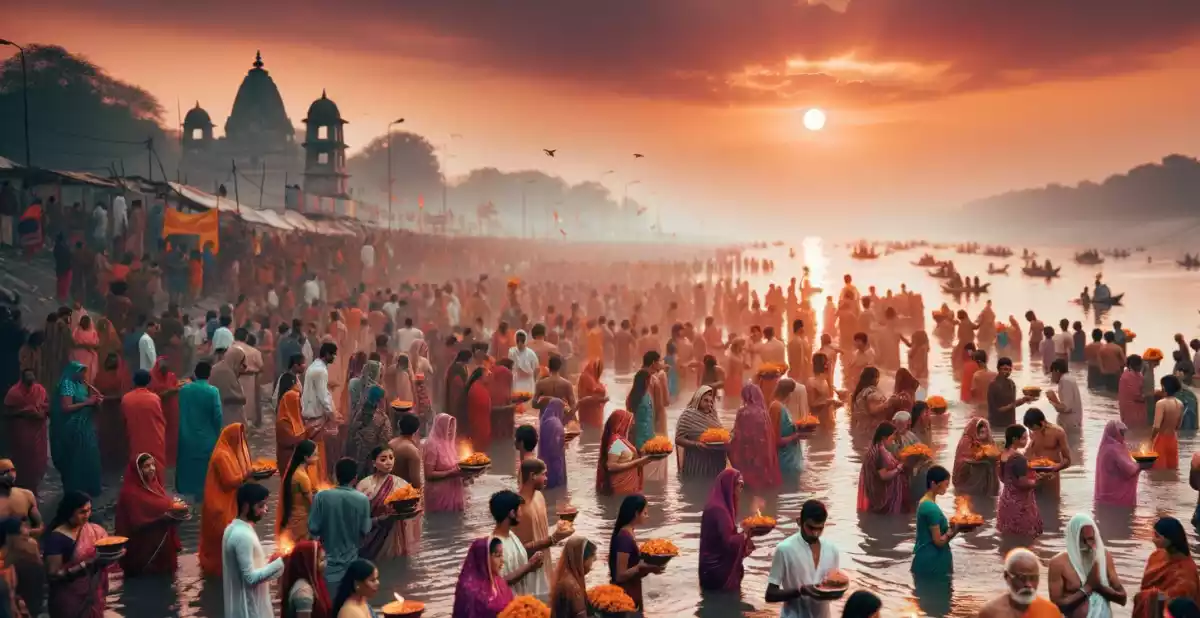
History of Chhath Puja
The history of Chhath Puja is deeply rooted in ancient Hindu traditions and epics. The festival, celebrated predominantly in Bihar, Jharkhand, and Eastern Uttar Pradesh of India, as well as in Nepal, has several historical and mythological associations. Here’s a glimpse into the rich history of Chhath Puja:
Ancient Origins
Chhath Puja is believed to predate even the ancient Vedic texts. The Rigveda contains hymns adoring the Sun god and describing similar rituals. The practices observed during Chhath have resemblances with the ones mentioned in these ancient texts.
Mythological Associations
- Mahabharata: One of the significant associations of Chhath Puja is with the Mahabharata. It’s believed that Draupadi, the queen of the Pandavas, had performed similar rituals. Additionally, Karna, the son of the Sun God, is said to have observed these rituals, standing in water and offering prayers to the Sun God.
- Ramayana: Another epic association is with the Ramayana. It’s believed that Lord Rama and Sita had observed a fast and offered prayers to the Sun God, marking the inception of Chhath Puja which continued to be celebrated with fervor upon their return to Ayodhya after an exile of 14 years.
Evolution Over Time
The festival has seen an evolution over the years. Initially, it was celebrated by royal families, and later, it became a significant festival among common people. The core essence of offering prayers to the Sun God for sustenance, health, and prosperity remained intact.
Significance in Modern Times
Chhath Puja continues to be a vibrant aspect of cultural and spiritual heritage in the aforementioned regions. The traditions and rituals have been carried forward through generations, embodying the age-old reverence for natural elements and celestial entities.
The history of Chhath Puja is a beautiful amalgamation of ancient traditions, mythological tales, and cultural evolution, that continues to resonate with the spiritual ethos of the devotees.
This history underscores the rich tapestry of cultural and spiritual traditions that have been nurtured and cherished over centuries, reflecting the profound human spirit of reverence and gratitude towards the forces of nature.
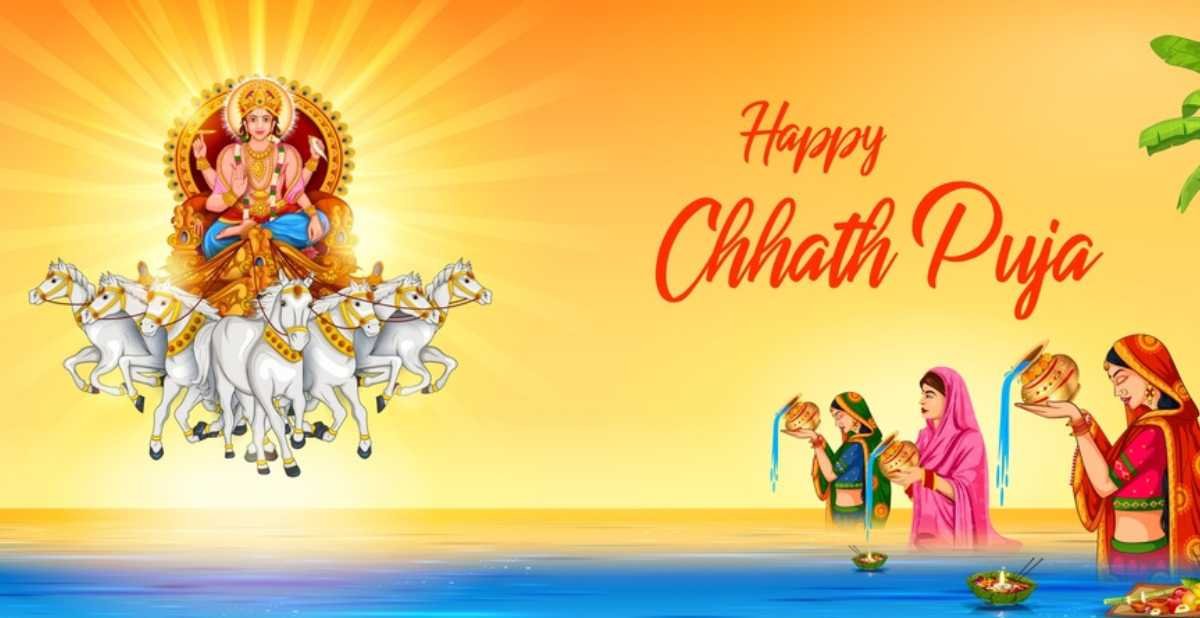
Chhath Puja Pride of Bihar
Chhath Puja is a festival that holds a special place in the hearts of the people of Bihar, transcending beyond a mere cultural event to embody a sense of belonging, tradition, and profound spirituality.
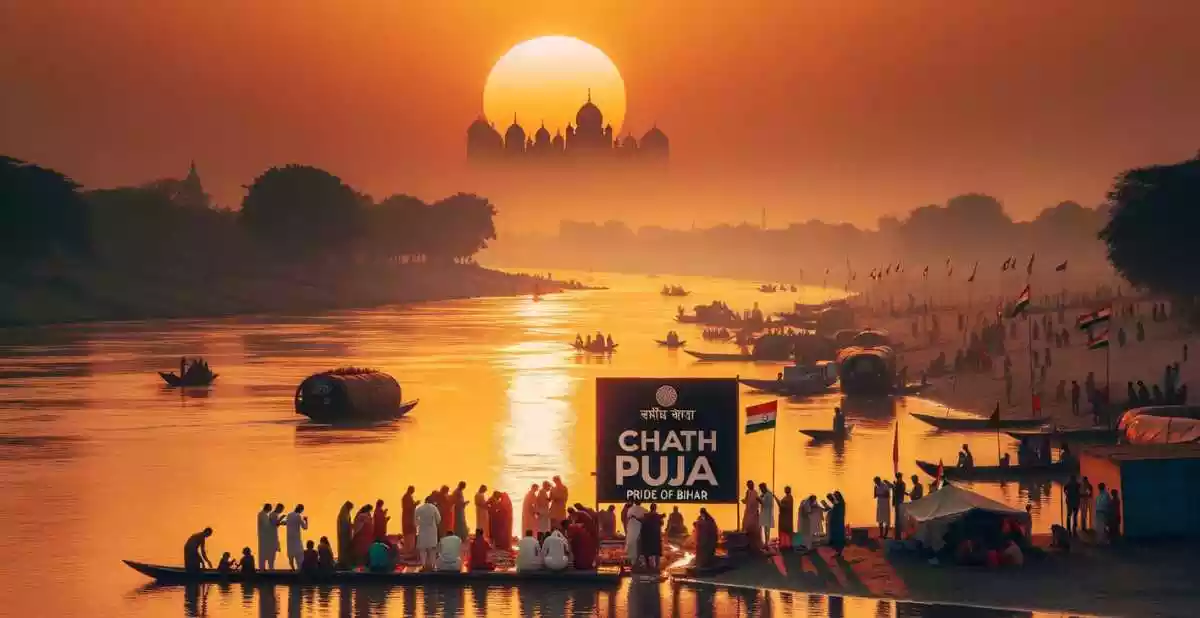
Cultural Identity:
Chhath Puja is deeply ingrained in the cultural fabric of Bihar. The festival, which venerates the Sun God, Surya, and Chhathi Maiya, has evolved over centuries and continues to be a robust expression of Bihari identity. Despite being celebrated in other regions, its roots remain strongly anchored in Bihar, establishing a profound cultural link between the festival and the land.
Spiritual Significance:
The spiritual essence of Chhath Puja resonates with the Bihari ethos. Through rigorous rituals and offerings to the Sun God, the festival underscores the importance of gratitude, purity, and the sustenance of life. The harmonious blend of spirituality and tradition in Chhath Puja reflects a deep-seated reverence for natural forces.
Community Bonding:
Chhath Puja fosters community bonding and instills a sense of belonging among Biharis. It’s a time when individuals, irrespective of their whereabouts, converge in Bihar to participate in communal prayers and rituals. The festival strengthens familial ties and nurtures the communal spirit, enriching the social fabric of Bihar.
Global Resonance:
Over time, Chhath Puja has transcended geographical boundaries, finding resonance among the Bihari diaspora globally. However, its core essence remains tightly bound to Bihar, symbolizing the enduring cultural and spiritual heritage of the region.
Traditional Continuity:
The meticulous observance of age-old rituals during Chhath Puja ensures the continuity of tradition, bridging generational gaps, and reinforcing the cultural heritage that Biharis take pride in.
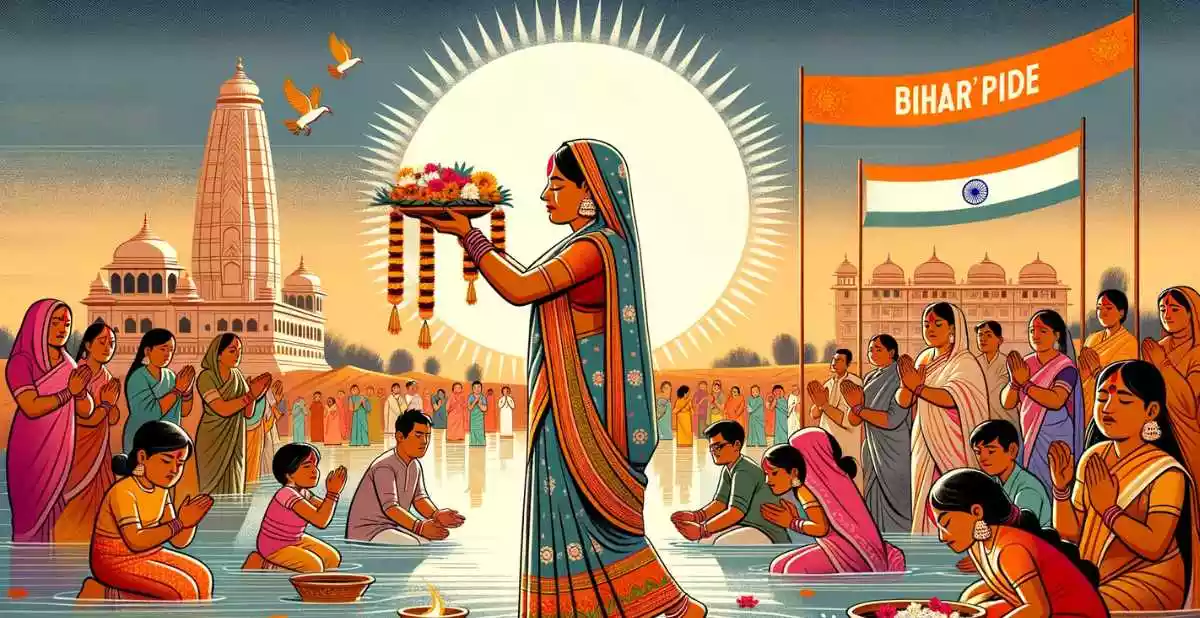
Benefits of performing Chhath Puja
- Spiritual Purification: Performing Chhath Puja is believed to purify the mind and body, enabling devotees to attain spiritual enlightenment.
- Health Benefits: The rituals associated with Chhath Puja, such as fasting and sun gazing, are believed to have health benefits, including improved immune system and energy levels.
- Divine Blessings: Devotees seek the blessings of Sun God, Surya, and Chhathi Maiya for good health, prosperity, and happiness for themselves and their families.
- Community Bonding: The festival fosters a sense of community and belonging among participants, strengthening social ties and promoting cultural heritage.
- Gratitude and Humility: The festival emphasizes the importance of expressing gratitude to natural forces and practising humility.
Chhath Puja Date Ritual
Chhath Puja, a significant festival dedicated to the Sun God, Surya, and Chhathi Maiya, is celebrated with immense reverence and devotion over four days. The festival in 2023 begins on November 17 and ends on November 20. Here’s a detailed description of the rituals and the respective days they are performed on:
- Day 1: Nahai Khay (November 17, 2023)
- On the first day, devotees take a holy bath, preferably in a river or a water body, and bring home the holy water to prepare offerings.
- The kitchen is cleaned before preparing the prasad (offerings).
- Day 2: Kharna (November 18, 2023)
- Devotees fast for the whole day and break their fast in the evening after worshipping the Sun God.
- Offerings of kheer (rice pudding), puris (deep-fried bread), and fruits are distributed among family and friends.
- Day 3: Sandhya Arghya (November 19, 2023)
- Devotees prepare offerings and present them to the setting sun.
- The offerings include thekua, a traditional sweet, and fruits among other things.
- This day is significant as it’s the main day of Chhath Puja.
- Day 4: Usha Arghya (November 20, 2023)
- On the final day, offerings are made to the rising sun, seeking blessings for a prosperous life and expressing gratitude.
The timings for the Chhath Puja rituals may vary depending on local customs and the place of celebration, but the primary rituals are performed at sunrise and sunset. The exact timing for the rituals in 2023 would start at 9:18 am on 18th November and end at 7:23 am on 19th November according to NAVI-pedia.
The table below encapsulates the rituals and dates for Chhath Puja 2023:
| Day | Ritual | Date |
| 1: Nahai Khay | Holy Bath, Preparing Offerings | November 17, 2023 |
| 2: Kharna | Fasting, Worship, Breaking Fast | November 18, 2023 |
| 3: Sandhya Arghya | Offering water to the God Sun. | November 19, 2023 |
| 4: Usha Arghya | Offering to Rising Sun | November 20, 2023 |
Each day of Chhath Puja carries a unique significance and involves meticulous rituals that underscore the devotees’ unwavering faith and gratitude towards the Sun God and Chhathi Maiya.
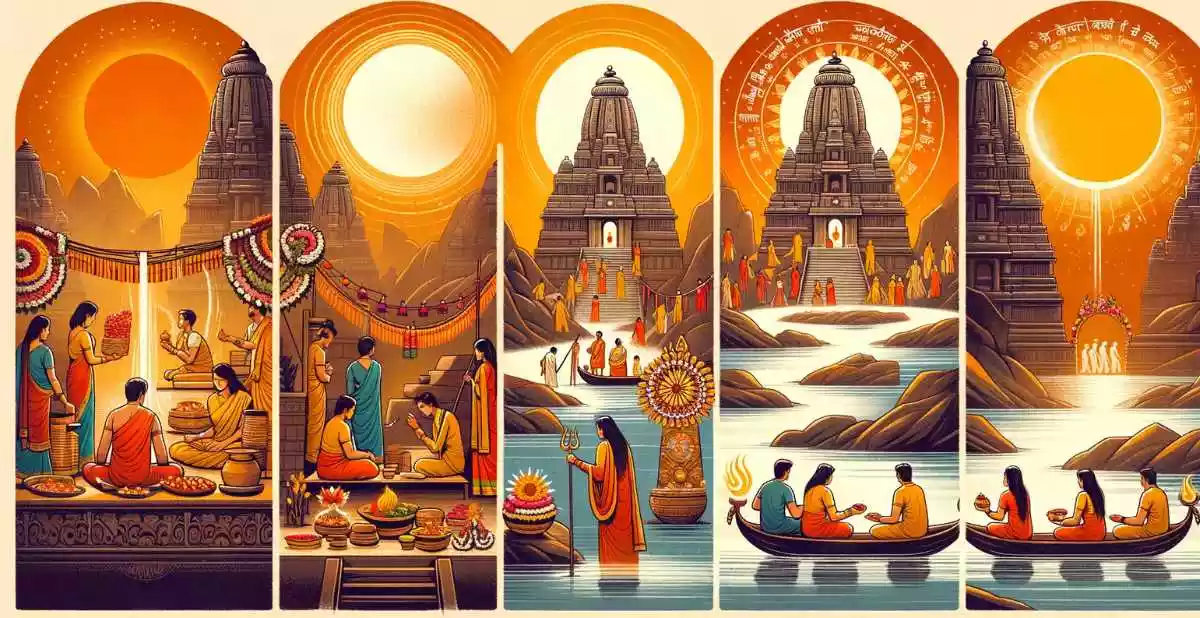
Top 10 Songs of Chhath Puja
Chhath Puja songs from various sources along with the artists who performed them. These songs are traditionally played during the festival to evoke the spiritual essence of Chhath Puja.
| Song Title | Artist(s) | Source |
|---|---|---|
| Kelwa Ke Path Par | Sharda Sinha | Youtube |
| Uga Hai Suraj Dev | Anuradha Paudwal | Youtube |
| Jhumka Giral Ba Chhathi Ghat Pe | Khesari Lal Yadav | Gaana3 |
| Chhathi Maiya | Khesari Lal Yadav, Antra Singh Priyanka | Gaana3 |
| Jai Chhathi Maiya | Sonu Nigam, Pawan Singh, Khushbhoo Jain | Gaana3 |
| Devare Ke Sangiya | Pawan Singh, Akshara Singh | Gaana4 |
| Dihi Darshan Suruj Gosaiya | Pawan Singh | Gaana4 |
| Ugi He Suruj Mal Naiyo Na Dole | Pawan Singh | Gaana4 |
Each song having its unique melody and lyrics that resonate with the spirit of the festival. Some of these songs have been cherished over the years and continue to be part of the Chhath Puja celebrations, signifying the enduring tradition and cultural richness of the festival.
How to do Chhath Puja
Chhath Puja Song :
Visit guideublog.com Home Page For More Information